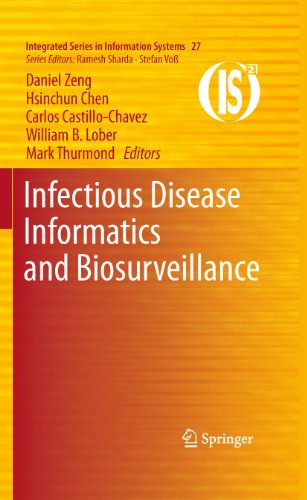مشاهده سبد خرید “An Unnatural History of Emerging Infections 2013” به سبد خرید شما اضافه شد.
Infectious Disease Informatics and Biosurveillance 2010
دانلود کتاب پزشکی انفورماتیک بیماریهای عفونی و مراقبت حیاتی
دسته: ابزار و تجهیزات, اپیدمیولوژی, بهداشت عمومی, پزشکی, عمومی
ناشر:
Springer US
| نویسنده |
Carlos Castillo-Chavez, Daniel Zeng, Hsinchun Chen, Mark Thurmond, William B. Lober |
|---|
| تعداد صفحهها |
488 |
|---|---|
| نوع فایل |
|
| حجم |
10 Mb |
| سال انتشار |
2010 |
89,000 تومان
دانلود ۳۰.۰۰۰ کتاب پزشکی فقط با قیمت یک کتاب و ۹۹ هزار تومان !
توضیحات
هدف این کتاب در مورد انفورماتیک بیماریهای عفونی (IDI) و نظارت زیستی ارائه دیدگاهی یکپارچه از وضعیت فعلی، شناسایی چالشها و فرصتهای فنی و سیاستگذاری و ترویج تحقیقات بینرشتهای است که از روششناسی جدید و آنچه ما از برنامههای نوآورانه آموختهایم بهره میبرد. این کتاب همچنین با تأکید بر دیدگاههای مبتنی بر انفورماتیک (به عنوان مثال، طراحی سیستم اطلاعات، استانداردهای داده، جنبههای محاسباتی الگوریتمهای نظارت حیاتی و ارزیابی سیستم) یک شکاف روششناختی در ادبیات را پر میکند. در نهایت، این کتاب تلاش میکند تا با انتقال واضح و مؤثر یافتههای تحقیقاتی اخیر در زمینه مطالعات موردی در IDI و نظارت زیستی، به سیاستگذاران و شاغلین دسترسی پیدا کند و فرصتهای عملی عمیقی را برای پزشکان فراهم کند تا درک خود را از ارزش افزایش دهند. کاربرد و محدودیت های راه حل های فنی این کتاب آخرین تحقیقات و دیدگاه های اخیر افراد و گروه های تحقیقاتی برجسته را در مورد آخرین تحقیقات فنی و سیاستی برای IDI و کاربرد آن در نظارت زیستی گرد هم می آورد. فصل های مشارکت در سه بخش گروه بندی می شوند. ماژول 1 یک نمای کلی از تحقیقات اخیر نظارت زیستی را ارائه می دهد که ساختارهای قانونی و خط مشی مربوطه را در زمینه IDI و فعالیت های نظارت زیستی جاری برجسته می کند. همچنین منابع دادههای IDI را شناسایی میکند در حالی که به مسائل مربوط به جمعآوری، اشتراک، و انتشار اطلاعات و همچنین ملاحظات اخلاقی میپردازد. ماژول دو شامل فصول نظرسنجی در مورد انواع روش های نظارتی مورد استفاده برای تجزیه و تحلیل داده های IDI در زمینه بهداشت عمومی و بیوتروریسم است. تکنیک های محاسباتی خاص تحت پوشش عبارتند از: متن کاوی، تجزیه و تحلیل سری های زمانی، روش های جریان داده های چندگانه، ترکیبی از روش های مشاهده ای، تجزیه و تحلیل و تجسم فضایی، تجزیه و تحلیل شبکه های اجتماعی، و شبیه سازی های مبتنی بر عامل. ماژول 3 فناوری اطلاعات و پشتیبانی تصمیم را برای پاسخ به رویدادهای بهداشت عمومی و دفاع زیستی بررسی می کند. درس های عملی آموخته شده در توسعه بهداشت عمومی و سیستم های نظارت حیاتی، پذیرش فناوری، و نظارت بر سندرم برای رویدادهای بزرگ مورد بحث قرار می گیرد. هدف این کتاب ارائه یک IDI بین رشتهای و مرجع نظارت زیستی قابل درک است که به عنوان یک کتاب درسی مستقل یا مرجع برای دانشجویان، محققان و پزشکان در بهداشت عمومی، دامپزشکی، آمار زیستی، سیستمهای اطلاعاتی، علوم کامپیوتر، مدیریت دولتی و سیاست
توضیحات(انگلیسی)
This book on Infectious Disease Informatics (IDI) and biosurveillance is intended to provide an integrated view of the current state of the art, identify technical and policy challenges and opportunities, and promote cross-disciplinary research that takes advantage of novel methodology and what we have learned from innovative applications. This book also fills a systemic gap in the literature by emphasizing informatics driven perspectives (e.g., information system design, data standards, computational aspects of biosurveillance algorithms, and system evaluation). Finally, this book attempts to reach policy makers and practitioners through the clear and effective communication of recent research findings in the context of case studies in IDI and biosurveillance, providing “hands-on” in-depth opportunities to practitioners to increase their understanding of value, applicability, and limitations of technical solutions. This book collects the state of the art research and modern perspectives of distinguished individuals and research groups on cutting-edge IDI technical and policy research and its application in biosurveillance. The contributed chapters are grouped into three units. Unit I provides an overview of recent biosurveillance research while highlighting the relevant legal and policy structures in the context of IDI and biosurveillance ongoing activities. It also identifies IDI data sources while addressing information collection, sharing, and dissemination issues as well as ethical considerations. Unit II contains survey chapters on the types of surveillance methods used to analyze IDI data in the context of public health and bioterrorism. Specific computational techniques covered include: text mining, time series analysis, multiple data streams methods, ensembles of surveillance methods, spatial analysis and visualization, social network analysis, and agent-based simulation. Unit III examines IT and decision support for public health event response and bio-defense. Practical lessons learned in developing public health and biosurveillance systems, technology adoption, and syndromic surveillance for large events are discussed. The goal of this book is to provide an understandable interdisciplinary IDI and biosurveillance reference either used as a standalone textbook or reference for students, researchers, and practitioners in public health, veterinary medicine, biostatistics, information systems, computer science, and public administration and policy.




